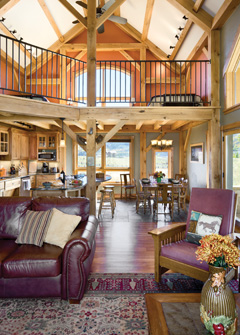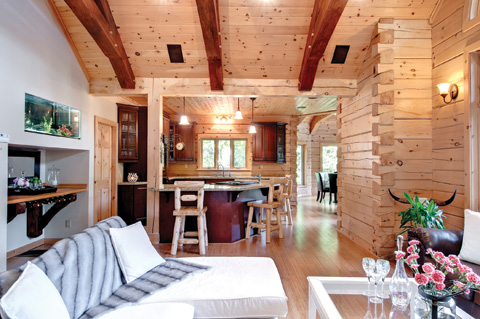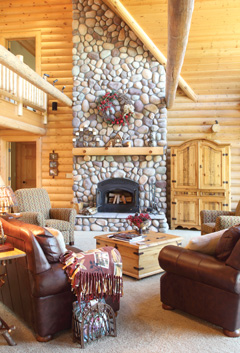The appeal of a log or timber home is the first indicator that such a dream dwelling is in a homeowner’s future. Both building materials captivate the imagination and conjure up images of days spent in leisure, enjoying beautiful mountain or lakeside vistas, watching wildlife, and generally relaxing. But which is best, log or timber?
Most often, the decision to build with log or timber comes down to that age-old bugaboo—pricing. Comparing the cost of log versus timber inevitably steers the prospective homeowner toward one or the other. Beginning the decision-making process requires some thought and a realistic assessment of the situation.
“First, establish a budget for the entire project,” recommends Jock Davidson, owner of Kozy Log Cabins. “Include 10 to 20 percent for overages and stick to the budget. Whittle down the number of manufacturers to be dealt with to a workable number, no more than three. More than that is too confusing. Then obtain their best quotes.”
True enough, a dollar spent in log construction is the same as a dollar spent in timber construction from a pure cost perspective. But understanding the “bang for the buck” is the essence of making the right decision for the individual homeowner, who must assess just what they are getting for their money.
“Request quotes and estimates from two or three reputable log and timber frame manufacturers,” adds Davidson. “Compare package contents, materials, and try to get feedback from at least two prior customers.”
Log and timber homes share common elements, but also have pronounced differences, and comparing these is an integral part of the exercise. Mike Orr, a sales consultant with Wisconsin Log Homes, relates, “There is so much that goes into building a custom home. Each and every finish is going to affect the overall cost. For example, if one company is bidding a 10-inch pine log and the other is bidding a 12-inch cedar log, the price will be very different just from that one finish option.”

OakBridge Timber Framing
“When you are comparing different companies and their pricing, you have to make sure you are comparing apples to apples. For us, as a hybrid log and timber provider, there is definitely a difference between log and timber homes. We generally see timber frame-style homes come in at a more economical price point than our log homes. Our log homes vary dramatically in price based on our products and what clients choose from our product line. For instance, if they choose our Cottage Log in Northern White Pine, it’s going to be less than our half-log with full log corners in Western Red Cedar.”
While the finished project will undoubtedly be satisfying, choosing log or timber construction includes the essential elements of pocketbook, trust in proven partners, and realistic perspective.
“Set the budget, identify the manufacturers you want to talk with, request plans, get price quotes, either evaluate the quotes or hire a third party to evaluate the quotes for you, make your decision, and then go for it!” Davisdon urges. “Carefully evaluate your budget and your needs versus wants. Determine the best product, size of home, options, and accessories for the money.” This basic process will often reveal the best choice in the log versus timber assessment.
The consultative process contributes to the decision as well. So take the time to get to know the people that represent the manufacturers being interviewed. Obviously, the voice of experience can help ease the choice of log or timber.
“Right from the start, we determine exactly what type of home the client is looking for and if we are the right fit for them,” comments Orr. “From there, we are here to educate our clients on all the options that are available to them and help guide them in a direction that is right for them and for their budget. We are very transparent with our clients regarding cost throughout the planning and design phase, so that there are no unexpected surprises throughout construction. We always want to make sure we are designing a home that fits within the client’s specifications while also meeting their financial expectations.”

1867 Confederation Log & Timber Frame
Perhaps, aside from cost, the primary influencer in the log and timber debate is simply the aesthetics of the proposed home. Looking at photos of finished homes, visiting several that have been completed, and evaluating floorplans will develop a more thorough understanding of the positive aspects of each. Further, looking at finishes is a key element in the program. Certain fixtures and furnishings may lend themselves more to log than to timber, or the opposite may be true. Questioning your consultant on these points will dispel any confusion and make the decisions on finishes easier.
Depending on the construction materials, the same floorplan may come in with a radically different price point. A consultant will help in the comparison of materials, particularly those that add or detract from the cost of the project most dramatically.
“Remember,” Orr advises, “Each company has its own way of doing business and its own building practices. So just make sure you have a firm grasp on what is being provided and what is not. Most importantly, make sure you trust the company you are working with. If you find a reputable company, they are going to be open and honest with you about pricing from the beginning and guide you in a direction that keeps you safe and gives you exactly what you are looking for within the amount you want to invest.”
Log and timber are both winners. Bear in mind that the final decision will be a lasting, tangible expression of your taste and personality.

